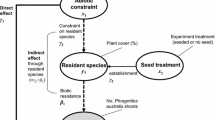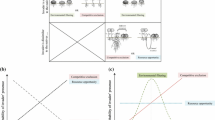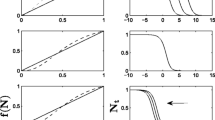Abstract
Spread rates of invasive plant species depend heavily on variable seed/seedling survivorships over various habitat types as well as on variability in seed dispersal induced by rapid transport of propagules in open areas and slow transport in vegetated areas. The ability to capture spatial variability in seed survivorship and dispersal is crucial to accurately predict the rate of spread of plants in real world landscapes. However, current analytic methods for predicting spread rates are not suited for arbitrary, spatially heterogeneous systems. Here, we analyze invasion rates of the invasive plant Phragmites australis (common reed) over variable wetland landscapes. Phragmites is one of the most pervasive perennial grasses, outcompeting native vegetation, providing poor wildlife habitat, and proving difficult to eradicate across its invasive range in North America. Phragmites spreads sexually via seeds and asexually via underground (rhizomes) and aboveground (stolons) stems. We construct a structured integrodifference equation model of the Phragmites life cycle capturing variable seed survivorship in a seed bank, sexual and asexual recruitment into a juvenile age class, and differential competition among all classes with adults. The demographic model is coupled with a homogenized ecological diffusion/settling seed dispersal model that allows for seed deposition that varies with habitat type. The dispersal kernel we develop does not require local normalization and can be implemented efficiently using standard computational techniques. The model generates a traveling wave of isolated patches, establishing only in suitable habitats. We use the method of multiple scales to predict invasion speed as a solvability condition at large scales and test the predictions numerically. Accurate predictions are generated for a wide range of landscape parameters, indicating that invasion speeds can be understood in landscapes of arbitrary structure using this approach.









Similar content being viewed by others
References
Able K, Hagan S, Brown S (2003) Mechanisms of marsh habitat alteration due to Phragmites: response of young-of-the-year mummichog (Fundulus heteroclitus) to treatment for Phragmites removal. Estuaries 26:484–494
Albert A, Brisson J, Belzile F, Turgeon J, Lavoie C (2015) Strategies for a successful plant invasion: the reproduction of Phragmites australis in northeastern North America. J Ecol 103(6):1529–1537
Alvarez M G, Tron F, Mauchamp A (2005) Sexual versus asexual colonization by Phragmites australis: 25-year reed dynamics in a Mediterranean marsh, southern France. Wetlands 25(3):639–647
Armstrong J, Afreen-Zobayed F, Blyth S, Armstrong W (1999) Phragmites australis: effects of shoot submergence on seedling growth and survival and radial oxygen loss from roots. Aquat Bot 64(3):275–289
Baldwin AH, Kettenring KM, Whigham DF (2010) Seed banks of Phragmites australis-dominated brackish wetlands: relationships to seed viability, inundation, and land cover. Aquat Bot 93(3):163–169
Bellavance ME, Brisson J (2010) Spatial dynamics and morphological plasticity of common reed (Phragmites australis) and cattails (Typha sp.) in freshwater marshes and roadside ditches. Aquat Bot 93(2):129–134
Burdick DM, Konisky RA (2003) Determinants of expansion for Phragmites australis, common reed, in natural and impacted coastal marshes. Estuaries 26(2):407–416
Byun C, Blois S, Brisson J (2013) Plant functional group identity and diversity determine biotic resistance to invasion by an exotic grass. J Ecol 101(1):128–139
Byun C, de Blois S, Brisson J (2015) Interactions between abiotic constraint, propagule pressure, and biotic resistance regulate plant invasion. Oecologia 178(1):285–296
Caswell H (1989) Analysis of life table response experiments I. Decomposition of effects on population growth rate. Ecol Model 46(3-4):221–237
Caswell H, Nisbet RM, de Roos AM, Tuljapurkar S (1997) Structured-population models: many methods, a few basic concepts. In Structured-Population Models in Marine, Terrestrial, and Freshwater Systems. Springer, US, pp 3–17
Chambers RM, Osgood DT, Bart DJ, Montalto F (2003) Phragmites australis invasion and expansion in tidal wetlands: interactions among salinity, sulfide, and hydrology. Estuaries 26(2):398–406
Clevering OA, Lissner J (1999) Taxonomy, chromosome numbers, clonal diversity and population dynamics of Phragmites australis. Aquat Bot 64(3):185–208
Clevering OA, van der Toorn J (2000) Observations on the colonization of a young polder area in the Netherlands with special reference to the clonal expansion of Phragmites australis. Folia Geobotanica 35(4):375–87
Dewhirst S, Lutscher F (2009) Dispersal in heterogeneous habitats: thresholds, spatial scales, and approximate rates of spread. Ecology 90(5):1338–1345
Fitzgibbon WE, Langlais M, Morgan JJ (2001) A mathematical model of the spread of feline leukemia virus (feLV) through a highly heterogeneous spatial domain. SIAM J Math Anal 33:570–588
Garlick MJ, Powell JA, Hooten MB, McFarlane LR (2011) Homogenization of large-scale movement models in ecology. Bull Math Biol 73(9):2088–2108
Garlick MJ, Powell JA, Hooten MB, MacFarlane LR (2014) Homogenization, sex, and differential motility predict spread of chronic wasting disease in mule deer in southern Utah. J Math Biol 69(2):369–399
Gilbert MA, White SM, Bullock JM, Gaffney EA (2014) Spreading speeds for stage structured plant populations in fragmented landscapes. J Theor Biol 349:135–149
Hazelton EL, McCormick MK, Sievers M, Kettenring KM, Whigham DF (2015) Stand age is associated with clonal diversity, but not vigor, community structure, or insect herbivory in Chesapeake Bay Phragmites australis. Wetlands 35(5):877–888
Hengeveld R (1988) Mechanisms of biological invasions. J Biogeogr 819–828
Holmes MH (1995) Introduction to perturbation methods. Springer, New York
Lathrop RG, Windham L, Montesano P (2003) Does Phragmites expansion alter the structure and function of marsh landscapes? Patterns and processes revisited. Estuaries 26(2):423–435
Keller BE (2000) Plant diversity in Lythrum, Phragmites, and Typha marshes, Massachusetts, USA. Wetl Ecol Manag 8:391–401
Kettenring KM, McCormick MK, Baron HM, Whigham DF (2010) Phragmites australis (common reed) invasion in the Rhode River subestuary of the Chesapeake Bay: disentangling the effects of foliar nutrients, genetic diversity, patch size, and seed viability. Estuar Coasts 33:118–126
Kettenring KM, McCormick MK, Baron HM, Whigham DF (2011) Mechanisms of Phragmites australis invasion: feedbacks among genetic diversity, nutrients, and sexual reproduction. J Appl Ecol 48:1305–1313
Kettenring KM, de Blois S, Hauber DP (2012a) Moving from a regional to a continental perspective of Phragmites australis invasion in North America. AoB Plants pls040
Kettenring KM, Garvie K, Hazelton ELG, Hough-Snee N, Ma Z (2012) Phragmites invasion and control in the Great Salt Lake watershed: 2012 land manager survey. Final report to the Utah Department of Natural Resources, Division of Forestry, Fire & State Lands, p 26
Kettenring KM, Mock KE (2012) Genetic diversity, reproductive mode, and dispersal differ between the cryptic invader, Phragmites australis, and its native conspecific. Biol Invasions 14:2489–2504
Kettenring KM, Whigham DF, Hazelton EL, Gallagher SK, Weiner HM (2015) Biotic resistance, disturbance, and mode of colonization impact the invasion of a widespread, introduced wetland grass. Ecol Appl 25:466–480
Kettenring KM, Mock KE, Zaman B, McKee M (2016) Life on the edge: reproductive mode and rate of invasive Phragmites australis patch expansion. Biol Invasions 18:2475–2495
Kirk H, Paul J, Straka J, Freeland JR (2011) Long-distance dispersal and high genetic diversity are implicated in the invasive spread of the common reed, Phragmites australis (Poaceae), in northeastern North America. Am J Bot 98(7):1180–1190
Kiviat E (2013) Ecosystem services of Phragmites in North America with emphasis on habitat functions. AoB Plants 5:plt008
Kot M, Lewis MA, van den Driessche P (1996) Dispersal data and the spread of invading organisms. Ecology 77(7):2027–42
Kulmatiski A, Beard KH, Meyerson LA, Gibson JR, Mock KE (2011) Nonnative Phragmites australis invasion into Utah wetlands. West N Am Nat 70:541–552
Lambertini C, Gustafsson M, Frydenberg J, Lissner J, Speranza M, Brix H (2006) A phylogeographic study of the cosmopolitan genus Phragmites (Poaceae) based on AFLPs. Plant Syst Evol 258:161–182
Lambertini C, Mendelssohn IA, Gustafsson MH, Olesen B, Tenna R, Sorrell BK, Brix H (2012a) Tracing the origin of Gulf Coast Phragmites (Poaceae): a story of long-distance dispersal and hybridization. Am J Bot 99:538–551
Lambertini C, Sorrell BK, Riis T, Olesen B, Brix H (2012b) Exploring the borders of European Phragmites within a cosmopolitan genus. AoB Plants: 2012 pls020
Long AL, Kettenring KM, Hawkins CP, et al. Wetlands (2017) Distribution and Drivers of a Widespread, Invasive Wetland Grass, Phragmites australis, in Wetlands of the Great Salt Lake, Utah, USA. doi:10.1007/s13157-016-0838-4
Marks M, Lapin B, Randall J (1994) Phragmites australis (P. communis): threats, management and monitoring. Nat Areas J 14:285–294
Mauchamp A, Blanch S, Grillas P (2001) Effects of submergence on the growth of Phragmites australis seedlings. Aquat Bot 69(2):147–164
McCormick MK, Kettenring KM, Baron HM, Whigham DF (2010a) Extent and reproductive mechanisms of Phragmites australis spread in brackish wetlands in Chesapeake Bay, Maryland (USA). Wetlands 30:67–74
McCormick MK, Kettenring KM, Baron HM, Whigham DF (2010b) Spread of invasive Phragmites australis in estuaries with differing degrees of development: genetic patterns, Allee efects and interpretation. J Ecol 98(6):1369–1378
McCormick MK, Brooks HE, Whigham DF (2016) Microsatellite analysis to estimate realized dispersal distance in Phragmites australis. Biol Invasions 18(9):2497–2504. doi:10.1007/s10530-016-1126-1
Meyerson LA, Cronin JT (2013) Evidence for multiple introductions of Phragmites australis to North America: detection of a new non-native haplotype. Biol Invasions 15:2605–2608
Meyerson LA, Lambert AM, Saltonstall K (2010) A tale of three lineages: expansion of common reed (Phragmites australis) in the US Southwest and Gulf Coast. Invasive Plant Sci Manag 3:515–520
Minchinton TE, Simpson JC, Bertness MD (2006) Mechanisms of exclusion of native coastal marsh plants by an invasive grass. J Ecol 94:342–354
Morales JM, Carlo TA (2006) The effects of plant distribution and frugivore density on the scale and shape of dispersal kernels. Ecology 87(6):1489–1496
Mozdzer TJ, Zieman JC (2010) Ecophysiological differences between genetic lineages facilitate the invasion of nonnative Phragmites australis in North American Atlantic coast wetlands. J Ecol 98(2):451–458
Neubert MG, Kot M, Lewis MA (1995) Dispersal and pattern formation in a discrete-time predator-prey model. Theor Popul Biol 48:7–43
Neubert MG, Caswell H (2000) Demography and dispersal: calculation and sensitivity analysis of invasion speed for structred populations. Ecology 81(6):1613–1628
Neupane RC, Powell JA (2015) Invasion speeds with active dispersers in highly variable landscapes: multiple scales, homogenization, and the migration of trees. J Theor Biol 387:111–119
Okubo A, Levin SA (1989) A theoretical framework for data analysis of wind dispersal of seeds and pollen. Ecology 70(2):329–338
Pastor J (2011) Mathematical ecology of populations and ecosystems. John Wiley and Sons; Aug 31
Powell JA, Zimmermann NE (2004) Multiscale analysis of active seed dispersal contributes to resolving Reid’s paradox. Ecology 85(2):490–506
Saltonstall K (2010) Cryptic invasion by a non-native genotype of the common reed, Phragmites australis into North America. Proc Natl Acad Sci 99:67–74
Sciance MB, Patrick CJ, Weller DE, et al. (2016) Local and regional disturbances associated with the invasion of Chesapeake Bay marshes by the common reed Phragmites australis. Biol Invasions 18(9):2661–2677. doi:10.1007/s10530-016-1136-z
Skellam JG (1951) Random dispersal in theoretical populations. Biometrika 38:196–218
Skalski GT, Gilliam JF (2003) A diffusion based theory of organism dispersal in heterogeneous populations. Am Nat 161(3):441–458
Saltonstall K (2002) Cryptic invasion by a non-native genotype of the common reed, Phragmites australis, into North America. Proc Natl Acad Sci 99:2445–2449
Shigesada N, Kawasaki K, Takeda Y (1995) Modeling stratified diffusion in biological invasions. Am Nat 229–251
ter Heerdt GN, Drost HJ (1994) Potential for the development of marsh vegetation from the seed bank after a drawdown. Biol Conserv 67(1):1–11
Tulbure MG, Johnston CA (2010) Environmental conditions promoting non-native Phragmites australis expansion in Great Lakes coastal wetlands. Wetlands 30(3):577–587
Turchin P (1998) Quantitative analysis of movement. Sinauer, Sunderland
van den Bosch F, Metz JAJ, Diekmann O (1990) The velocity of spatial population expansion. J Math Biol 28:529–565
Vanderlinder MS, Neale CM, Rosenberg DE, Kettenring KM (2013) Use of remote sensing to assess changes in wetland plant communities over an 18-year period: a case study from the Bear River Migratory Bird Refuge, Great Salt Lake, Utah. West N Am Nat 74:33–46
Weisner SE (1987) The relation between wave exposure and distribution of emergent vegetation in a eutrophic lake. Freshw Biol 18:537–544
Weisner SE, Graneli W, Ekstam B (1993) Influence of submergence on growth of seedlings of Scirpus lacustris and Phragmites australis. Freshw Biol 29(3):371–375
Whyte RS, Trexel-Kroll D, Klarer DM, Shields R, Francko DA (2008) The invasion and spread of Phragmites australis during a period of low water in a Lake Erie coastal wetland. J Coast Res 111– 120
Wilcox DA (2012) Response of wetland vegetation to the post-1986 decrease in Lake St. Clair water levels: seed-bank emergence and beginnings of the Phragmites australis invasion. J Great Lakes Res 38(2):270–277
Author information
Authors and Affiliations
Corresponding author
Rights and permissions
About this article
Cite this article
Duncan, J.P., Rozum, R.N., Powell, J.A. et al. Multi-scale methods predict invasion speeds in variable landscapes. Theor Ecol 10, 287–303 (2017). https://doi.org/10.1007/s12080-017-0329-0
Received:
Accepted:
Published:
Issue Date:
DOI: https://doi.org/10.1007/s12080-017-0329-0




